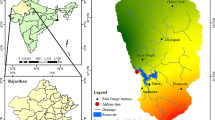Abstract
In recent years, functional networks have emerged as an extension of artificial neural networks (ANNs). In this article, we apply both network techniques to predict the catches of the Prionace Glauca (a class of shark) and the Katsowonus Pelamis (a variety of tuna, more commonly known as the Skipjack). We have developed an application that will help reduce the search time for good fishing zones and thereby increase the fleet’s competitivity. Our results show that, thanks to their superior learning and generalisation capacities, functional networks are more efficient than ANNs. Our data proceeds from remote sensors. Their spectral signatures allow us to calculate products that are useful for ecological modelling. After an initial phase of digital image processing, we created a database that provides all the necessary patterns to train both network types.







Similar content being viewed by others
References
Komatsu t, Aoki I, Mitani I, Ishii T (1994) Prediction of the catch of Japanese sardine larvae in Sagami Bay using a neural network. Fish Sci 60(4):385–391
Brosse S, Guegan J-F, Tourenq J-N, Lek S (1999) The use of artificial neural networks to assess fish abundance and spacial occupancy in the litoral zone of a mesotropic lake. Ecol Model 120:299–311
Dreyful-Leon, M (1999) Individual-based modelling of fishermen search behaviour with neural networks and reinforcement learning. Ecol Model 120:287–297
Groves DJ, Smye SW, Kinsey SE, Richards SM, Chessells JM, Eden OB, Bailey CC (1999) A comparison of Cox Regresión and neural networks for risk stratification in cases of acute lymphoblastic leukemia in children. Neur Comp Appl 8:257–264
Aussem A, Hill D (2000) Neural-network metamodelling for the prediction of Caulerpa taxifolia development in the Mediterranean sea. Neurocomputing 30:71–78
Castillo E, Gutiérrez JM (1998) Nonlinear time series modeling and prediction using functional networks. Extracting information masked by chaos. Phys Lett A 244:71–84
Castillo E, Cobo A, Gutiérrez JM, Pruneda E (1999) Introduction to functional networks with applications. A neural based paradigm. Kluwer, Amsterdam
Castillo E, Gutiérrez JM, Cobo A, Castillo C (2000) A minimax method for learning functional networks. Neur Proc Lett11(1):39–49
Castillo E, Cobo A, Gutiérrez JM, Pruneda E (1999) Working with differential, functional and difference equations using functional networks. Appl Math Model 23:89–107
Murtagh F, Zheng G, Campbell JG, Aussem A (2000) Neural network modelling for environmental prediction. Neurocomputing 30:65–70
Yang MD, Sykes RM, Merry CJ (2000) Estimation of algal biological parameters using water quality modeling and SPOT satellite data. Ecol Model 125:1–13
Kohonen T (1998) The self-organizing map. Neurocomputing 21:1–6
Foody GM (1999) Applications of the self-organising feature map neural network in community data analysis. Ecol Model 120:97–107
Kwan HK, Lee CK (1993) A neural network approach to pulse radar detection. IEEE Trans Aero Elect Sys 29:9–21
Author information
Authors and Affiliations
Corresponding author
Rights and permissions
About this article
Cite this article
Iglesias, A., Arcay, B., Cotos, J.M. et al. A comparison between functional networks and artificial neural networks for the prediction of fishing catches. Neural Comput & Applic 13, 24–31 (2004). https://doi.org/10.1007/s00521-004-0402-7
Received:
Accepted:
Published:
Issue Date:
DOI: https://doi.org/10.1007/s00521-004-0402-7




